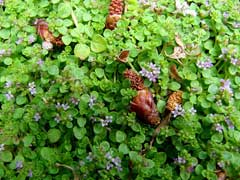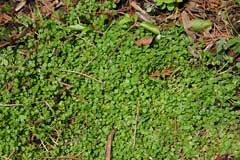 |
|
www.flickr.com/photos/edgeplot |
 |
| http://commons.wikimedia.org/wiki/User:SB_Johnny |
Translate this page:
Summary
Mentha species
Mint species (Lamiaceae or Labiatae) are a family of aromatic plants native to Europe, Africa and Asia. With over 30 genera and 600 species, they are one of the most prominent families of flowering plants. Mints are characterised by their square stems, opposite leaves, and often strong minty smell. Some familiar genera include Mentha (peppermint, spearmint), Salvia (sage) and Lavandula (lavender). Mint species are grown for their aromatic edible leaves eaten raw or cooked. Use as a flavouring in salads, cooked foods, or herb teas. Many mints thrive in moist spots in partial shade. Some mint species are invasive, increasing by a network of runners. Leaves are available all year. Popular mints are Peppermint (Mentha × piperita), Spearmint (M. spicata), Scotch Spearmint (M. x gracilis), Cornmint (M. arvensis) and Apple Mint (M. suaveolens). You may also want to try: Water Mint (M. aquatica), Horsemint (M. longifolia), Pennyroyal (M. pulegium), Corsican Mint (M. requienii) and Apple Mint/Bowles’ Mint (M. x villosa alopecuroides). All have excellent, tasty leaves.
Harvesting: Leaves are harvested 30 days after planting and then throughout the growing season, from spring to autumn, but they are best harvested just before flowering for optimal flavour. Flowers are harvested from late spring to early summer.
Physical Characteristics

 Mentha requienii is a PERENNIAL growing to 0.1 m (0ft 4in) by 0.5 m (1ft 8in) at a fast rate.
Mentha requienii is a PERENNIAL growing to 0.1 m (0ft 4in) by 0.5 m (1ft 8in) at a fast rate.
See above for USDA hardiness. It is hardy to UK zone 6 and is not frost tender. It is in flower from July to August. The species is hermaphrodite (has both male and female organs) and is pollinated by Insects. The plant is self-fertile.
It is noted for attracting wildlife.
Suitable for: light (sandy), medium (loamy) and heavy (clay) soils and can grow in heavy clay soil. Suitable pH: mildly acid, neutral and basic (mildly alkaline) soils. It can grow in semi-shade (light woodland) or no shade. It prefers moist soil.
UK Hardiness Map
US Hardiness Map
Synonyms
Plant Habitats
Ground Cover; Cultivated Beds;
Edible Uses
Edible Parts: Leaves
Edible Uses: Condiment Tea
Leaves - raw or cooked. A very strong peppermint-like aroma, it is used as a flavouring in salads, cooked foods and liqueurs[183]. A herb tea is made from the leaves.
References More on Edible Uses
Medicinal Uses
Plants For A Future can not take any responsibility for any adverse effects from the use of plants. Always seek advice from a professional before using a plant medicinally.
Antiseptic Carminative Febrifuge
A tea made from the leaves of most mint species has traditionally been used in the treatment of fevers, headaches, digestive disorders and various minor ailments[222]. The leaves are harvested as the plant comes into flower and can be dried for later use[238]. The essential oil in the leaves is antiseptic, though it is toxic in large doses[222].
References More on Medicinal Uses
The Bookshop: Edible Plant Books
Our Latest books on Perennial Plants For Food Forests and Permaculture Gardens in paperback or digital formats.

Edible Tropical Plants
Food Forest Plants for Hotter Conditions: 250+ Plants For Tropical Food Forests & Permaculture Gardens.
More

Edible Temperate Plants
Plants for Your Food Forest: 500 Plants for Temperate Food Forests & Permaculture Gardens.
More

More Books
PFAF have eight books available in paperback and digital formats. Browse the shop for more information.
Shop Now
Other Uses
Essential Repellent Strewing
Agroforestry uses:
Mint can be used as a ground cover, helping to suppress weeds and prevent soil erosion. Its strong aroma can also help deter pests.
An essential oil with a strong peppermint scent is obtained from the whole plant. Rats and mice intensely dislike the smell of mint. The plant was, therefore, used in homes as a strewing herb and has also been spread in granaries to keep the rodents off the grain[244]. An ornamental ground cover plant[183]. 1. Nectary - Flowers rich in nectar and pollen:
Yes – Mint species produce small flowers that are rich in nectar, attracting various pollinators, including bees and butterflies.
2. Wildlife - Food (Fruit, Seeds, Leaf litter, Shelter, Nesting, Roosting):
Yes – The leaves of mint are edible and can be used as food for both humans and some wildlife. While mint plants do not typically provide nesting sites, their dense foliage can offer some shelter.
3. Invertebrate Shelter (Overwintering sites, Leaf litter, Groundcover):
Yes – Mint can provide habitat for invertebrates, and its foliage contributes to leaf litter. Mint species can spread and act as ground cover, which can help create a suitable environment for beneficial insects.
4. Pest Confuser (Smell):
Yes – Mint has a strong aroma that can help deter certain pests, making it beneficial in companion planting and pest management strategies.
Special Uses
Attracts Wildlife Food Forest Ground cover Scented Plants
References More on Other Uses
Cultivation details
Mint species are generally self-fertile.
Reaching only 1-3 cm in height. Succeeds in most soils and situations so long as the soil is not too dry[200]. This species of mint will grow in drier soils than the other mints[245]. It also grows well in heavy clay soils. A sunny position is best for production of essential oils, but it also succeeds in partial shade. Prefers a shady position[188]. Fairly tolerant of being walked on, it grows well in the cracks of paving stones and also as a lawn with thyme and camomile[245]. This species is not hardy in all areas of Britain[238]. However, the plant usually self-sows even when the parent plant is killed by frost[238]. The whole plant is strongly aromatic with a peppermint aroma[245]. The flowers are very attractive to bees and butterflies. A good companion plant for growing near cabbages and tomatoes, helping to keep them free of insect pests. Members of this genus are rarely if ever troubled by browsing deer[233]. The plant is heat tolerant in zones 9 through 6. (Plant Hardiness Zones show how well plants withstand cold winter temperatures.
Plant Heat Zones show when plants would start suffering from the heat.
The Plant Heat Zone map is based on the number of "heat days" experienced in a given area where the temperature climbs to over 86 degrees F (30°C).
At this temperature, many plants begin to suffer physiological damage. Heat Zones range from 1 (no heat days) to 12 (210 or more heat days).
For example Heat Zone. 11-1 indicates that the plant is heat tolerant in zones 11 through 1.) For polyculture design as well as the above-ground architecture (form - tree, shrub etc. and size shown above) information on the habit and root pattern is also useful and given here if available. A clumping mat former. Forming a dense prostrate carpet with a limited spread [1-2]. The root pattern is rhizomatous with underground stems sending roots and shoots along their length [1-2]. The root pattern is stoloniferous rooting from creeping stems above the ground [1-2]. Mint leaves can be harvested throughout the growing season, from spring to autumn, but they are best harvested just before flowering for optimal flavor.
Mint typically flowers from late spring to early summer. Mint is a fast-growing plant, often establishing itself quickly and spreading aggressively, making it suitable for quick ground cover in gardens.
References Carbon Farming Information and Carbon Sequestration Information
Temperature Converter
Type a value in the Celsius field to convert the value to Fahrenheit:
Fahrenheit:
The PFAF Bookshop
Plants For A Future have a number of books available in paperback and digital form. Book titles include Edible Plants, Edible Perennials, Edible Trees,Edible Shrubs, Woodland Gardening, and Temperate Food Forest Plants. Our new book is Food Forest Plants For Hotter Conditions (Tropical and Sub-Tropical).
Shop Now
Plant Propagation
Seed - sow spring in a cold frame. Germination is usually fairly quick. Prick out the seedlings into individual pots when they are large enough to handle and plant them out in the summer. Mentha species are very prone to hybridisation and so the seed cannot be relied on to breed true. Even without hybridisation, seedlings will not be uniform and so the content of medicinal oils etc will vary. When growing plants with a particular aroma it is best to propagate them by division[K]. Division can be easily carried out at almost any time of the year, though it is probably best done in the spring or autumn to allow the plant to establish more quickly. Virtually any part of the root is capable of growing into a new plant. Larger divisions can be planted out direct into their permanent positions. However, for maximum increase it is possible to divide the roots up into sections no more than 3cm long and pot these up in light shade in a cold frame. They will quickly become established and can be planted out in the summer.
Other Names
If available other names are mentioned here
Native Range
EUROPE: Corse, Italy, Sardegna,
Weed Potential
Right plant wrong place. We are currently updating this section.
Please note that a plant may be invasive in one area but may not in your area so it's worth checking.
Conservation Status
IUCN Red List of Threatened Plants Status :

Growth: S = slow M = medium F = fast. Soil: L = light (sandy) M = medium H = heavy (clay). pH: A = acid N = neutral B = basic (alkaline). Shade: F = full shade S = semi-shade N = no shade. Moisture: D = dry M = Moist We = wet Wa = water.
Now available:
Food Forest Plants for Mediterranean Conditions
350+ Perennial Plants For Mediterranean and Drier Food Forests and Permaculture Gardens.
[Paperback and eBook]
This is the third in Plants For A Future's series of plant guides for food forests tailored to
specific climate zones. Following volumes on temperate and tropical ecosystems, this book focuses
on species suited to Mediterranean conditions—regions with hot, dry summers and cool, wet winters,
often facing the added challenge of climate change.
Read More
Expert comment
Author
Benth.
Botanical References
17
Links / References
For a list of references used on this page please go here
Readers comment
© 2010, Plants For A Future. Plants For A Future is a charitable company limited by guarantee, registered in England and Wales. Charity No. 1057719, Company No. 3204567.